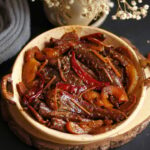Braised fish is a familiar dish in the meals of Vietnamese people and it goes really well with rice. A pot of braised fish that meets the traditional standard must have firm, fragrant, and non-fishy meat, and especially, the fish bones must be soft enough to be edible. However, not everyone has the opportunity to braise fish on a wood stove or bury it in husks like the traditional way. So, how can we braise fish with a gas stove or an electric pot while still ensuring the delicious and authentic flavor? This article will guide you on how to braise fish until the bones are soft, not fishy, and flavorful right at home.
1. Choosing fresh ingredients and fish processing is the most important factor
To make delicious and non-fishy braised fish, the first thing you need to do is to choose fresh fish. The fish should have clear eyes, bright red gills, firm meat, and no foul smell. Common types of fish used for braising include carp, basa, mackerel, and mackerel scad. Each type of fish will be suitable for a different braising style.
Tip for processing fish to reduce the fishy smell:
- Wash the fish with diluted salt water, white wine, or crushed ginger to remove the fishy smell.
- Completely remove the black membrane inside the belly of the fish as it is the cause of the foul odor.
- If you want the fish to be firmer, after cleaning, you should rinse it with boiling water before braising.

2. Essential spices that create the soul of braised fish
Each style of braised fish will have its own unique blend of spices. In addition, depending on family tastes and regional preferences, there may be variations in the spices used for braised fish, but the following are some common styles and their corresponding spices:
Braised fish with soybean paste: Use fermented soybean paste, fish sauce, galangal, lemongrass, MSG, and turmeric.
Braised fish with pickled vegetables: Combine pickled mustard greens, fish sauce, and MSG.
Braised fish with green bananas: Includes green bananas, pork belly, tea leaves, salt, and fish sauce.
Braised fish with galangal and turmeric: Use sliced galangal, lemongrass, turmeric, pork belly, and fish sauce.
Additionally, you can add a few green chilies to enhance the spicy flavor and reduce the fishy smell. Especially, using tea leaves to line the bottom of the pot will not only make the fish more aromatic but also prevent it from sticking to the pot. Some localities use Vietnamese coriander, polygonum leaves, star fruit, or sour grapes in the braising process, which also adds a unique fragrance. Lining the bottom of the pot with fresh sugarcane is another way to impart a distinctive flavor to the dish.

3. Secret tips to make the fish bones soft and tender
Instead of spending 8-12 hours braising on a wood stove like in the old days, you can now use an electric pot to achieve the same result without putting in too much effort. To make the fish bones soften faster:
- Pour boiling water over the fish after processing to make the fish firmer. When braising, use hot water instead of cold water.
- Add a little rice vinegar or lemon juice to the pot while braising. The mild acid will help break down the calcium in the bones, making them softer.
- Line the bottom of the pot with pork skin, split sugarcane, or tea leaves. This not only prevents burning but also makes the fish taste sweeter and richer due to the natural gelatin released from the pork skin.

4. How to create an appealing color for the braised fish
Color is an important factor in making braised fish attractive. Instead of using ready-made caramel coloring, you can make your own by caramelizing sugar:
Put sugar in a pan and heat it over low heat until it turns brown and emits a fragrant smell, then pour it into the pot with the fish.
Additionally, you can use cashew oil or Korean chili powder if you want the fish to have a reddish-brown color.

5. Instructions for braising fish with an electric pot – Soft bones, flavorful, and no need to monitor constantly
The following are the detailed steps to braise fish with an electric pot, which is convenient for busy homemakers:
Step 1: Line the bottom of the pot with a layer of pork skin, tea leaves, or galangal and lemongrass.
Step 2: Place the marinated fish on top. You can also sprinkle a layer of galangal, dried shallots, green chilies, or pepper, depending on your preference.
Step 3: Pour in boiling water just enough to cover the surface of the fish. Avoid using cold water as it may cause the fish to taste fishy.
Step 4: Turn on the pot to the “cook” mode and let the fish simmer for about 5 minutes. Then switch to the “warm” mode to let the fish absorb the flavors gradually. You can repeat this process a few times within 6-8 hours.
Step 5: Towards the end, turn on the “cook” mode again to reduce the liquid and intensify the flavors and colors of the dish.
When using an electric pot, you can leave the braised fish in the “warm” mode for several hours without worrying about it burning. Meanwhile, you can attend to other tasks or go out without any concerns.
Braised fish is not only delicious but also nutritious due to the calcium from the fish bones. Even without the traditional methods of using firewood or husks, you can still create authentic-tasting braised fish at home with a gas stove or an electric pot. Just remember some simple tips like using boiling water, adding vinegar, lining the pot with tea leaves, and making the right caramel coloring, and you’ll have a delicious, soft, and flavorful braised fish dish without spending too much time or effort.
Are you ready to try making this traditional braised fish dish for your family? Go for it!
The Ultimate Guide to Fish Cookery: Transforming Your Dish with a Handful of Magic Leaves
For centuries, chefs have been experimenting with various ingredients to eliminate the pungent odor of fish, tenderize the meat, and enhance its flavor and appearance. One of the best-kept secrets in the culinary world is the use of tea leaves. This traditional technique is a game-changer, transforming the humble fish into a culinary masterpiece.
The Ultimate Guide to a Mouth-watering, Flavourful Fish Stew: A Secret Ingredient that will Make Everyone Beg for More!
“Unleash the secret weapon for your culinary creations – a handful of fresh herbs! With this simple addition, your humble fish stew will be transformed into a masterpiece that will have your guests raving. It’s an easy yet powerful trick that will elevate your dish to new heights of flavor and aroma.”






































